Personal and Professional Development: Analysis and Strategies Report
VerifiedAdded on 2020/06/04
|6
|1337
|1177
Report
AI Summary
This report delves into the multifaceted realm of personal and professional development. It begins by delineating the similarities and distinctions between personal and professional growth, emphasizing the benefits for individuals and organizations. The report then examines how organizations and professional bodies support such development, including legal implications. Various methods for undertaking personal and professional development are analyzed, along with resource considerations and selection criteria. Furthermore, it assesses current skills and competencies against role requirements, culminating in the creation and monitoring of a personal and professional development plan. The report underscores the importance of strategic planning, skill enhancement, and continuous self-assessment to achieve professional success.
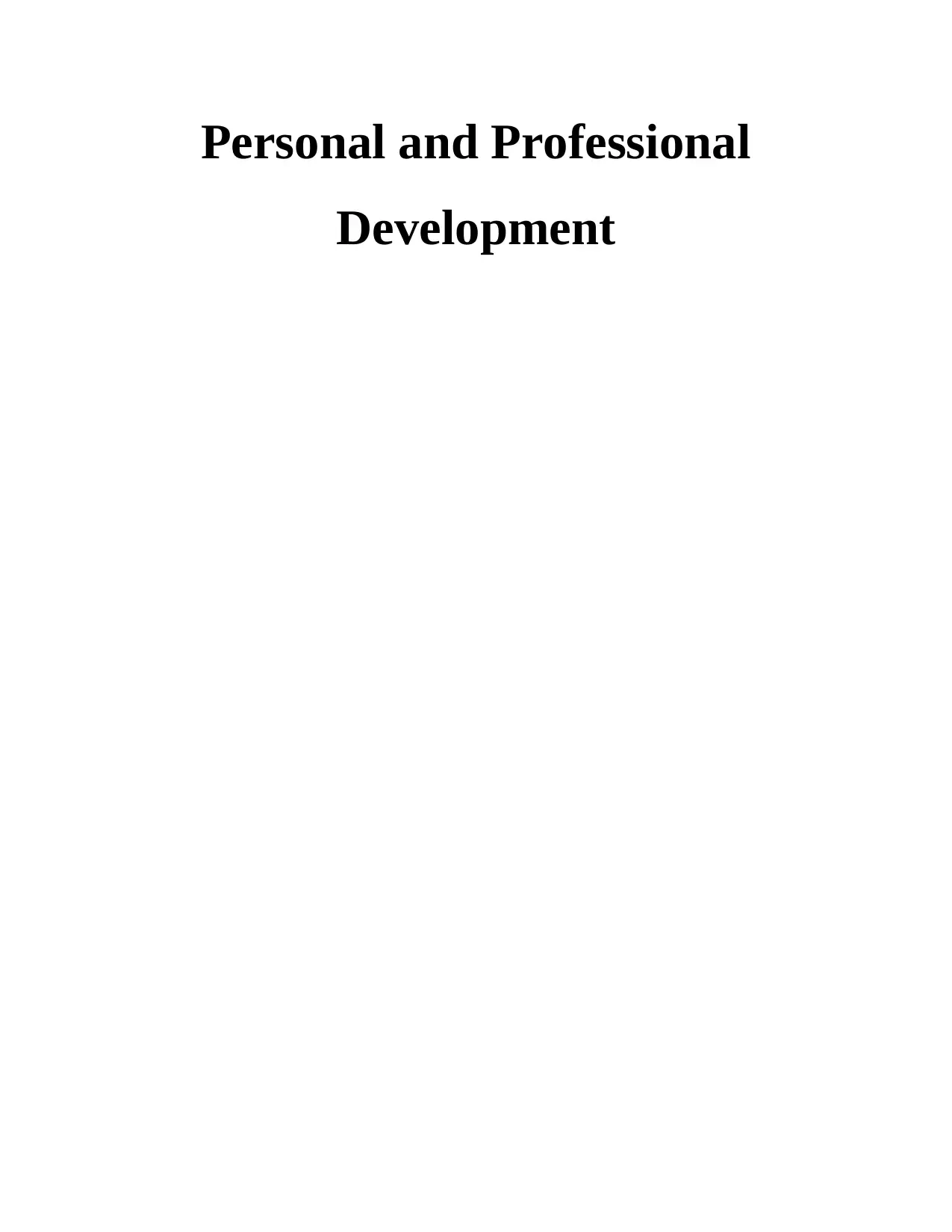
Personal and Professional
Development
Development
Paraphrase This Document
Need a fresh take? Get an instant paraphrase of this document with our AI Paraphraser
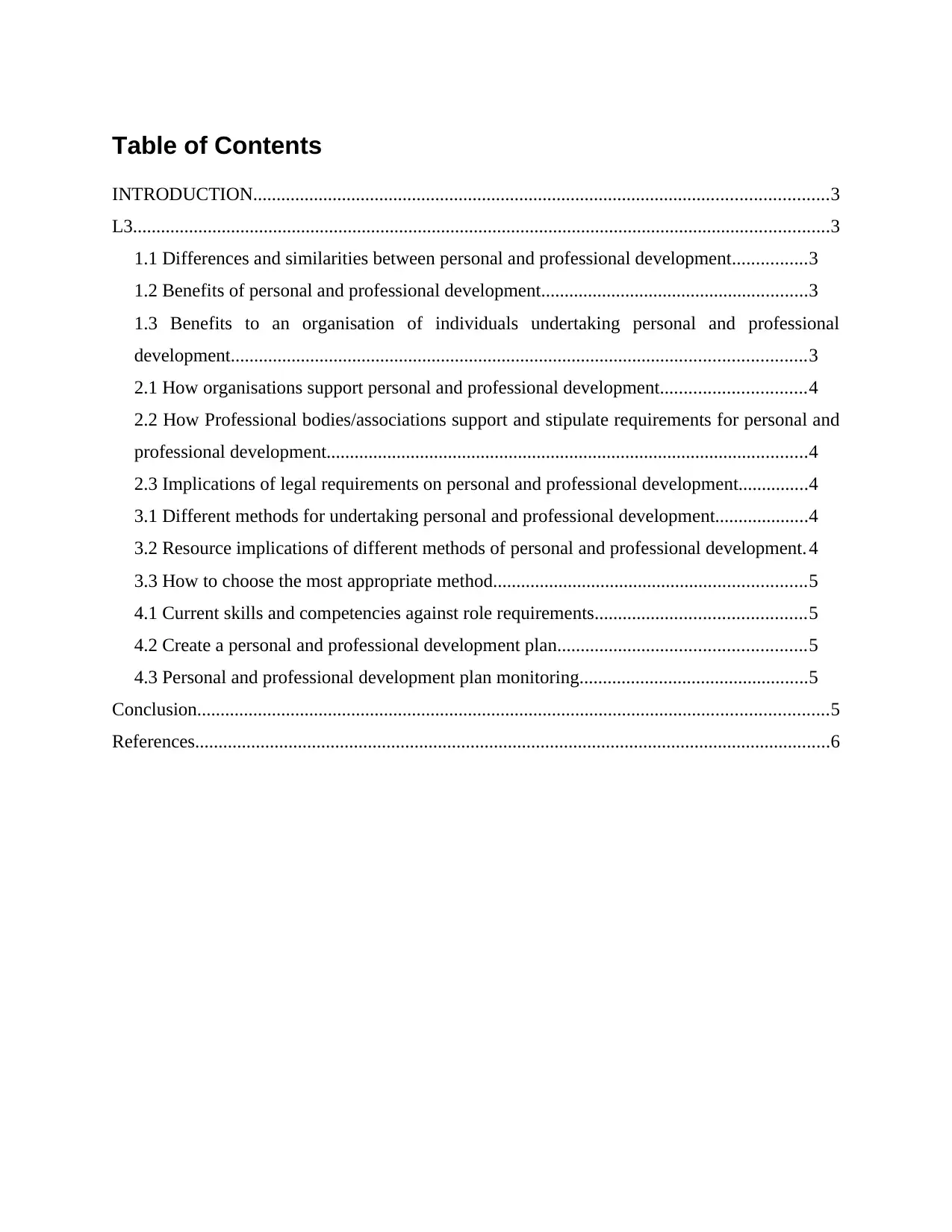
Table of Contents
INTRODUCTION...........................................................................................................................3
L3.....................................................................................................................................................3
1.1 Differences and similarities between personal and professional development................3
1.2 Benefits of personal and professional development.........................................................3
1.3 Benefits to an organisation of individuals undertaking personal and professional
development...........................................................................................................................3
2.1 How organisations support personal and professional development...............................4
2.2 How Professional bodies/associations support and stipulate requirements for personal and
professional development.......................................................................................................4
2.3 Implications of legal requirements on personal and professional development...............4
3.1 Different methods for undertaking personal and professional development....................4
3.2 Resource implications of different methods of personal and professional development. 4
3.3 How to choose the most appropriate method...................................................................5
4.1 Current skills and competencies against role requirements.............................................5
4.2 Create a personal and professional development plan.....................................................5
4.3 Personal and professional development plan monitoring.................................................5
Conclusion.......................................................................................................................................5
References........................................................................................................................................6
INTRODUCTION...........................................................................................................................3
L3.....................................................................................................................................................3
1.1 Differences and similarities between personal and professional development................3
1.2 Benefits of personal and professional development.........................................................3
1.3 Benefits to an organisation of individuals undertaking personal and professional
development...........................................................................................................................3
2.1 How organisations support personal and professional development...............................4
2.2 How Professional bodies/associations support and stipulate requirements for personal and
professional development.......................................................................................................4
2.3 Implications of legal requirements on personal and professional development...............4
3.1 Different methods for undertaking personal and professional development....................4
3.2 Resource implications of different methods of personal and professional development. 4
3.3 How to choose the most appropriate method...................................................................5
4.1 Current skills and competencies against role requirements.............................................5
4.2 Create a personal and professional development plan.....................................................5
4.3 Personal and professional development plan monitoring.................................................5
Conclusion.......................................................................................................................................5
References........................................................................................................................................6
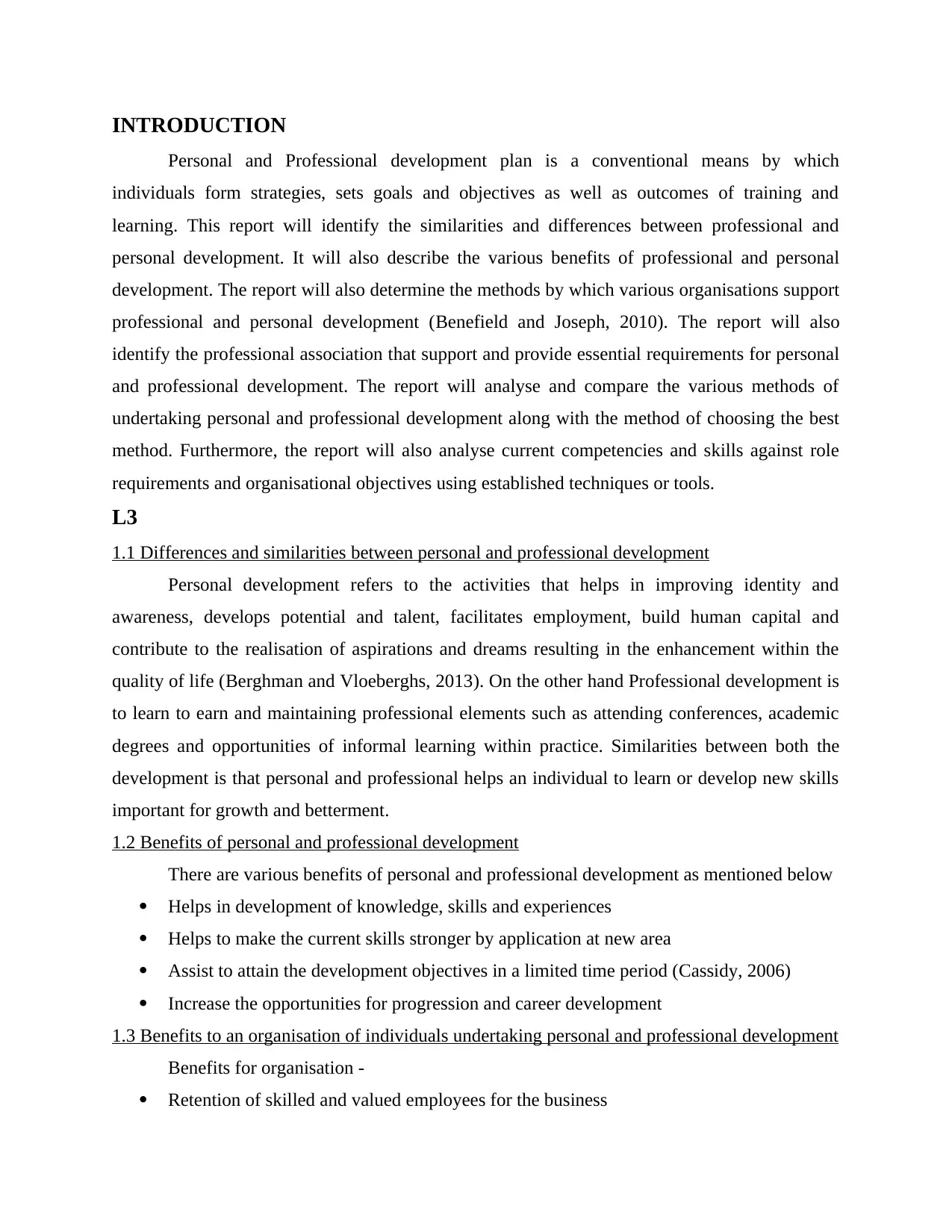
INTRODUCTION
Personal and Professional development plan is a conventional means by which
individuals form strategies, sets goals and objectives as well as outcomes of training and
learning. This report will identify the similarities and differences between professional and
personal development. It will also describe the various benefits of professional and personal
development. The report will also determine the methods by which various organisations support
professional and personal development (Benefield and Joseph, 2010). The report will also
identify the professional association that support and provide essential requirements for personal
and professional development. The report will analyse and compare the various methods of
undertaking personal and professional development along with the method of choosing the best
method. Furthermore, the report will also analyse current competencies and skills against role
requirements and organisational objectives using established techniques or tools.
L3
1.1 Differences and similarities between personal and professional development
Personal development refers to the activities that helps in improving identity and
awareness, develops potential and talent, facilitates employment, build human capital and
contribute to the realisation of aspirations and dreams resulting in the enhancement within the
quality of life (Berghman and Vloeberghs, 2013). On the other hand Professional development is
to learn to earn and maintaining professional elements such as attending conferences, academic
degrees and opportunities of informal learning within practice. Similarities between both the
development is that personal and professional helps an individual to learn or develop new skills
important for growth and betterment.
1.2 Benefits of personal and professional development
There are various benefits of personal and professional development as mentioned below
Helps in development of knowledge, skills and experiences
Helps to make the current skills stronger by application at new area
Assist to attain the development objectives in a limited time period (Cassidy, 2006)
Increase the opportunities for progression and career development
1.3 Benefits to an organisation of individuals undertaking personal and professional development
Benefits for organisation -
Retention of skilled and valued employees for the business
Personal and Professional development plan is a conventional means by which
individuals form strategies, sets goals and objectives as well as outcomes of training and
learning. This report will identify the similarities and differences between professional and
personal development. It will also describe the various benefits of professional and personal
development. The report will also determine the methods by which various organisations support
professional and personal development (Benefield and Joseph, 2010). The report will also
identify the professional association that support and provide essential requirements for personal
and professional development. The report will analyse and compare the various methods of
undertaking personal and professional development along with the method of choosing the best
method. Furthermore, the report will also analyse current competencies and skills against role
requirements and organisational objectives using established techniques or tools.
L3
1.1 Differences and similarities between personal and professional development
Personal development refers to the activities that helps in improving identity and
awareness, develops potential and talent, facilitates employment, build human capital and
contribute to the realisation of aspirations and dreams resulting in the enhancement within the
quality of life (Berghman and Vloeberghs, 2013). On the other hand Professional development is
to learn to earn and maintaining professional elements such as attending conferences, academic
degrees and opportunities of informal learning within practice. Similarities between both the
development is that personal and professional helps an individual to learn or develop new skills
important for growth and betterment.
1.2 Benefits of personal and professional development
There are various benefits of personal and professional development as mentioned below
Helps in development of knowledge, skills and experiences
Helps to make the current skills stronger by application at new area
Assist to attain the development objectives in a limited time period (Cassidy, 2006)
Increase the opportunities for progression and career development
1.3 Benefits to an organisation of individuals undertaking personal and professional development
Benefits for organisation -
Retention of skilled and valued employees for the business
⊘ This is a preview!⊘
Do you want full access?
Subscribe today to unlock all pages.

Trusted by 1+ million students worldwide
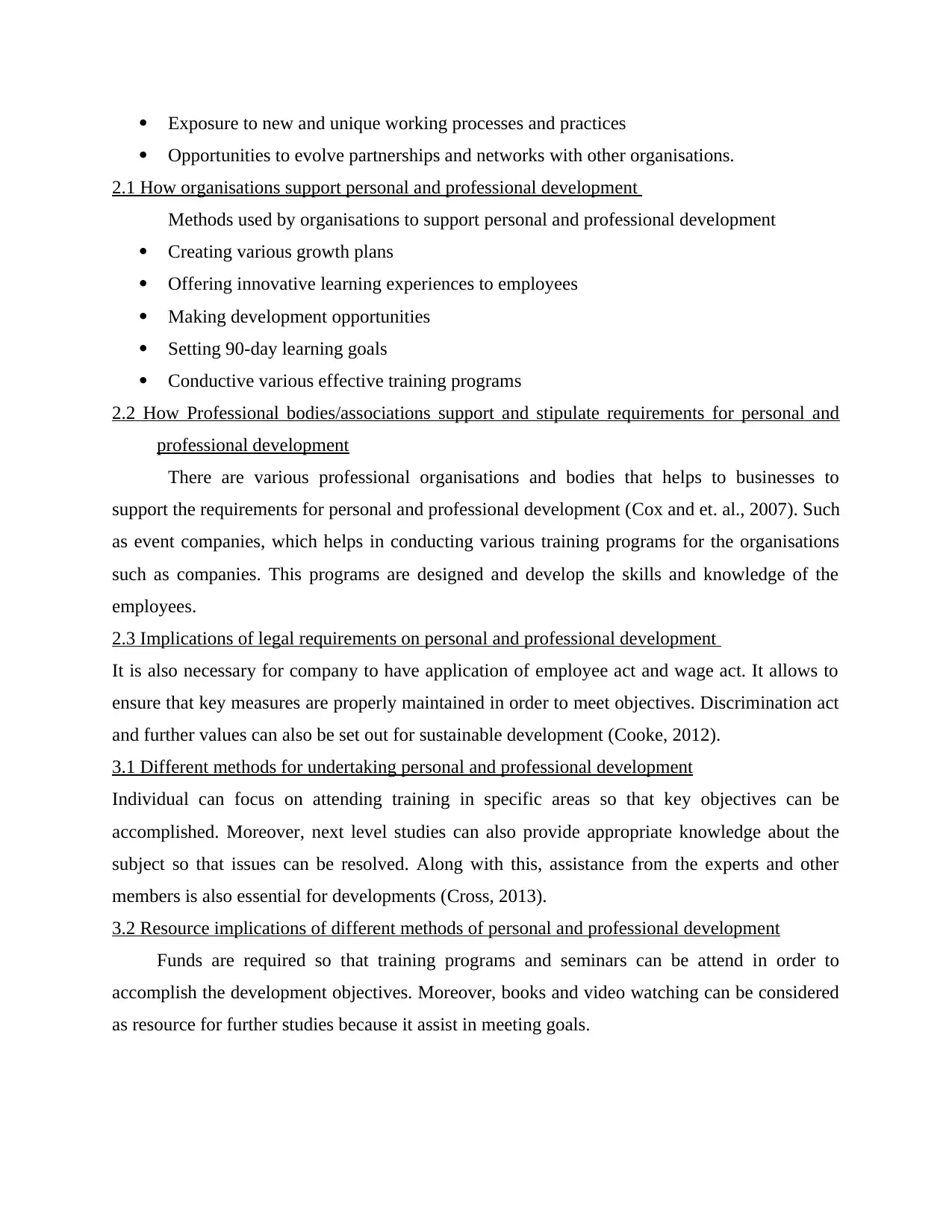
Exposure to new and unique working processes and practices
Opportunities to evolve partnerships and networks with other organisations.
2.1 How organisations support personal and professional development
Methods used by organisations to support personal and professional development
Creating various growth plans
Offering innovative learning experiences to employees
Making development opportunities
Setting 90-day learning goals
Conductive various effective training programs
2.2 How Professional bodies/associations support and stipulate requirements for personal and
professional development
There are various professional organisations and bodies that helps to businesses to
support the requirements for personal and professional development (Cox and et. al., 2007). Such
as event companies, which helps in conducting various training programs for the organisations
such as companies. This programs are designed and develop the skills and knowledge of the
employees.
2.3 Implications of legal requirements on personal and professional development
It is also necessary for company to have application of employee act and wage act. It allows to
ensure that key measures are properly maintained in order to meet objectives. Discrimination act
and further values can also be set out for sustainable development (Cooke, 2012).
3.1 Different methods for undertaking personal and professional development
Individual can focus on attending training in specific areas so that key objectives can be
accomplished. Moreover, next level studies can also provide appropriate knowledge about the
subject so that issues can be resolved. Along with this, assistance from the experts and other
members is also essential for developments (Cross, 2013).
3.2 Resource implications of different methods of personal and professional development
Funds are required so that training programs and seminars can be attend in order to
accomplish the development objectives. Moreover, books and video watching can be considered
as resource for further studies because it assist in meeting goals.
Opportunities to evolve partnerships and networks with other organisations.
2.1 How organisations support personal and professional development
Methods used by organisations to support personal and professional development
Creating various growth plans
Offering innovative learning experiences to employees
Making development opportunities
Setting 90-day learning goals
Conductive various effective training programs
2.2 How Professional bodies/associations support and stipulate requirements for personal and
professional development
There are various professional organisations and bodies that helps to businesses to
support the requirements for personal and professional development (Cox and et. al., 2007). Such
as event companies, which helps in conducting various training programs for the organisations
such as companies. This programs are designed and develop the skills and knowledge of the
employees.
2.3 Implications of legal requirements on personal and professional development
It is also necessary for company to have application of employee act and wage act. It allows to
ensure that key measures are properly maintained in order to meet objectives. Discrimination act
and further values can also be set out for sustainable development (Cooke, 2012).
3.1 Different methods for undertaking personal and professional development
Individual can focus on attending training in specific areas so that key objectives can be
accomplished. Moreover, next level studies can also provide appropriate knowledge about the
subject so that issues can be resolved. Along with this, assistance from the experts and other
members is also essential for developments (Cross, 2013).
3.2 Resource implications of different methods of personal and professional development
Funds are required so that training programs and seminars can be attend in order to
accomplish the development objectives. Moreover, books and video watching can be considered
as resource for further studies because it assist in meeting goals.
Paraphrase This Document
Need a fresh take? Get an instant paraphrase of this document with our AI Paraphraser

3.3 How to choose the most appropriate method
By having a proper identification of needs the selection of process can be advanced in
desired manner. Along with this, key outcome in regard to application of measures can be
accomplished through appropriate needs identification (Beausaert and et. Al., 2013).
4.1 Current skills and competencies against role requirements
Communication skills
Computer skills
Observation skills
Time Management skills
4.2 Create a personal and professional development plan
Personal Objectives Action Plan Required Resources Required
Enhancement of skills
for better functions
Proper Scheduling of
activities
Training sessions are
essential so as to
manage time
Leadership skills Attending training
sessions, conferences,
meetings and seminars
Improving monitoring
4.3 Personal and professional development plan monitoring
By having a proper observation of results the monitoring of development plan can be taken into
account more effectively. Day to day feedback from seniors can also advance the effectiveness
of monitoring system (Cunningham, 2016).
CONCLUSION
As per above study, it can be concluded that personal and professional development can
be accomplished through proper scheduling. Skills like leadership and other managerial values
helps in development of professional values.
By having a proper identification of needs the selection of process can be advanced in
desired manner. Along with this, key outcome in regard to application of measures can be
accomplished through appropriate needs identification (Beausaert and et. Al., 2013).
4.1 Current skills and competencies against role requirements
Communication skills
Computer skills
Observation skills
Time Management skills
4.2 Create a personal and professional development plan
Personal Objectives Action Plan Required Resources Required
Enhancement of skills
for better functions
Proper Scheduling of
activities
Training sessions are
essential so as to
manage time
Leadership skills Attending training
sessions, conferences,
meetings and seminars
Improving monitoring
4.3 Personal and professional development plan monitoring
By having a proper observation of results the monitoring of development plan can be taken into
account more effectively. Day to day feedback from seniors can also advance the effectiveness
of monitoring system (Cunningham, 2016).
CONCLUSION
As per above study, it can be concluded that personal and professional development can
be accomplished through proper scheduling. Skills like leadership and other managerial values
helps in development of professional values.
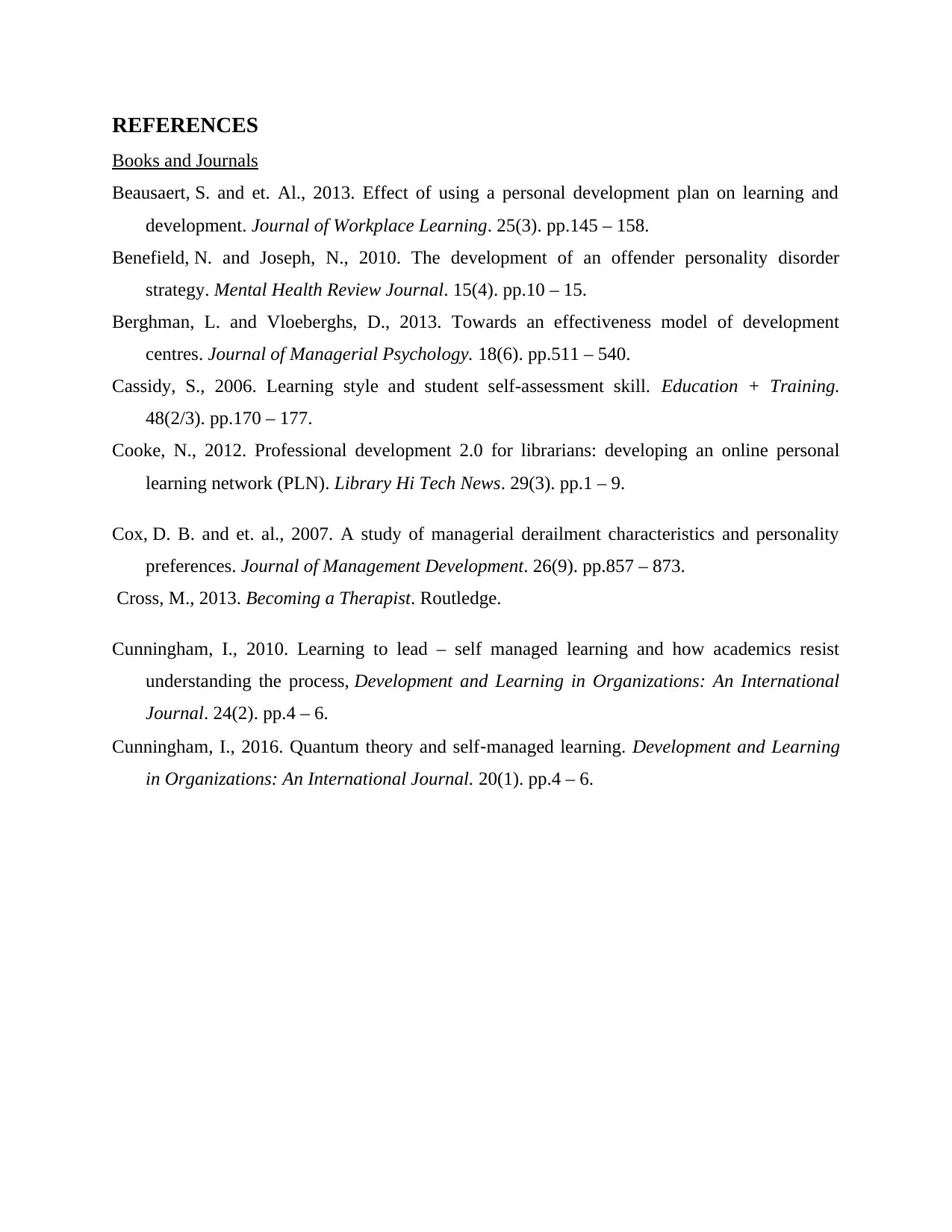
REFERENCES
Books and Journals
Beausaert, S. and et. Al., 2013. Effect of using a personal development plan on learning and
development. Journal of Workplace Learning. 25(3). pp.145 – 158.
Benefield, N. and Joseph, N., 2010. The development of an offender personality disorder
strategy. Mental Health Review Journal. 15(4). pp.10 – 15.
Berghman, L. and Vloeberghs, D., 2013. Towards an effectiveness model of development
centres. Journal of Managerial Psychology. 18(6). pp.511 – 540.
Cassidy, S., 2006. Learning style and student self-assessment skill. Education + Training.
48(2/3). pp.170 – 177.
Cooke, N., 2012. Professional development 2.0 for librarians: developing an online personal
learning network (PLN). Library Hi Tech News. 29(3). pp.1 – 9.
Cox, D. B. and et. al., 2007. A study of managerial derailment characteristics and personality
preferences. Journal of Management Development. 26(9). pp.857 – 873.
Cross, M., 2013. Becoming a Therapist. Routledge.
Cunningham, I., 2010. Learning to lead – self managed learning and how academics resist
understanding the process, Development and Learning in Organizations: An International
Journal. 24(2). pp.4 – 6.
Cunningham, I., 2016. Quantum theory and self‐managed learning. Development and Learning
in Organizations: An International Journal. 20(1). pp.4 – 6.
Books and Journals
Beausaert, S. and et. Al., 2013. Effect of using a personal development plan on learning and
development. Journal of Workplace Learning. 25(3). pp.145 – 158.
Benefield, N. and Joseph, N., 2010. The development of an offender personality disorder
strategy. Mental Health Review Journal. 15(4). pp.10 – 15.
Berghman, L. and Vloeberghs, D., 2013. Towards an effectiveness model of development
centres. Journal of Managerial Psychology. 18(6). pp.511 – 540.
Cassidy, S., 2006. Learning style and student self-assessment skill. Education + Training.
48(2/3). pp.170 – 177.
Cooke, N., 2012. Professional development 2.0 for librarians: developing an online personal
learning network (PLN). Library Hi Tech News. 29(3). pp.1 – 9.
Cox, D. B. and et. al., 2007. A study of managerial derailment characteristics and personality
preferences. Journal of Management Development. 26(9). pp.857 – 873.
Cross, M., 2013. Becoming a Therapist. Routledge.
Cunningham, I., 2010. Learning to lead – self managed learning and how academics resist
understanding the process, Development and Learning in Organizations: An International
Journal. 24(2). pp.4 – 6.
Cunningham, I., 2016. Quantum theory and self‐managed learning. Development and Learning
in Organizations: An International Journal. 20(1). pp.4 – 6.
⊘ This is a preview!⊘
Do you want full access?
Subscribe today to unlock all pages.

Trusted by 1+ million students worldwide
1 out of 6
Related Documents
Your All-in-One AI-Powered Toolkit for Academic Success.
+13062052269
info@desklib.com
Available 24*7 on WhatsApp / Email
![[object Object]](/_next/static/media/star-bottom.7253800d.svg)
Unlock your academic potential
Copyright © 2020–2025 A2Z Services. All Rights Reserved. Developed and managed by ZUCOL.



